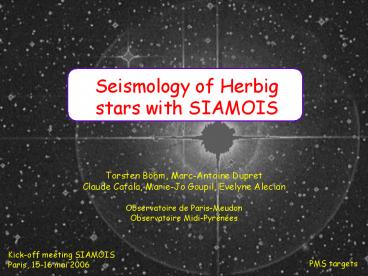Seismology of Herbig stars with SIAMOIS - PowerPoint PPT Presentation
Title:
Seismology of Herbig stars with SIAMOIS
Description:
Kick-off meeting SIAMOIS. Paris, 15-16 mai 2006. PMS targets. Seismology of Herbig. stars with SIAMOIS. Torsten B hm, Marc-Antoine Dupret ... – PowerPoint PPT presentation
Number of Views:55
Avg rating:3.0/5.0
Title: Seismology of Herbig stars with SIAMOIS
1
Seismology of Herbigstars with SIAMOIS
- Torsten Böhm, Marc-Antoine Dupret
- Claude Catala, Marie-Jo Goupil, Evelyne Alecian
- Observatoire de Paris-Meudon
- Observatoire Midi-Pyrénées
2
Lets talk about
- Main observational properties of Herbig stars
- Seismic potential of Herbig stars
- probing the internal structure of PMS stars
- HD 104237 a very good target for SIAMOIS
- Discovery of 8 pulsating modes in HD 104237
- Preliminary seismic study of HD 104237
- Improvements expected with SIAMOIS
3
Herbig Ae/Be stars
- very young pre-main sequence objects
- observational definition (Herbig, 1960) -
spectral type earlier than F0 - presence of emission lines
- embedded region
- proximity of reflection nebula
- intermediate masses (1.5 - 8 solar masses)
- signs of intense activity and strong stellar
winds - In addition jets, outflows, IR excess, X-ray
sources, presence of CS disks, detection of
magnetic fields, .
4
HR diagram
ZAMS
5
Herbig Ae/Be stars
- very young pre-main sequence objects
- observational definition (Herbig, 1960) -
spectral type earlier than F0 - presence of emission lines
- embedded region
- proximity of reflection nebula
- intermediate masses (1.5 - 8 solar masses)
- signs of intense activity and strong stellar
winds - In addition jets, outflows, IR excess, X-ray
sources, presence of CS disks, detection of
magnetic fields, .
6
Discovery of pulsating Herbig Ae stars
- - the d Scuti instability strip crosses the
location of HAeBes in the HR diagram - Until now, only some Herbig stars between A2 and
F0 have been - identified pulsating
- V588 Mon
- V599 Mon P lt 3h (multip.)
(Breger,1972) - HR5999 P approx 6 hrs (Kurtz Marang
1995) - HD 104237 P approx 40 minutes (Donati, 1997)
- some recent discoveries (approx 15 stars as of
today)
7
Potential of Herbig stars for asteroseismology
Probing the internal physics of stars in the
early stages of evolution
Location of the convective core
Initial nuclear burning (CNO cycle)
8
Probing the convective core in the early stages
of evolution
Evolution tracks
Brunt Vaisala freq.
9
Comparison PreMS PostMS frequencies
Small separation
10
Potential of Herbig stars for asteroseismology
Probing the internal physics of stars in the
early stages of evolution
Location of the convective core
Initial nuclear burning (CNO cycle)
11
HD 104237 - a PMS prototype star
- Emission line star (Herbig Ae )
- Southern hemisphere (-78)
- mV approx 6.5
- Mass 2.3 solar masses
- Luminosity 35 solar lum
- Log Teff 3.93
- Spectral type A4IVesh
- Vsini 12km/s
- Highly active and variable (spectro)
- Stellar wind 500km/s
- Multiple system (spectrosc. binary)
12
Previous work
13
High resolution spectroscopic data base
- SAAO 04/1999 1 week
- SAAO 04/2000 1 week GIRAFFE
- SAAO 05/2000 2 weeks
- Mt Stromlo 04/00 1 week
- data reduction ESPRIT/ LSD (multiplex
information) - cross-correllation of telluric lines
- 100m/s precision on vrad (per spectrum)
- 1888 spectra
- - total of 42 nights
14
SAAO at Sutherland
15
Orbital analysis
SAAO Avril Mt Stromlo Avril 2000
SAAO Mai 2000
16
5 ascertained 3 probable frequencies
Böhm et al. 2004, AA 427, 907
17
5 ascertained 3 probable frequencies
18
1999
19
1999 3 probables frequencies?
20
2000 (total)
21
Observations and modelisation 1999
SAAO
22
Rotational Modulation - 95 hrs Period
Halpha
23
Preliminary seismic study
ZAMS
A primary B secondary
24
Preliminary seismic study
M2.7 M0
M2.2 M0
25
Preliminary seismic study
Observed frequencies
26
Preliminary seismic study
M2.7 M0
M2.2 M0
27
Preliminary seismic study
28
Preliminary seismic study
M2.7 M0
M2.2 M0
29
(No Transcript)
30
Second order effect
More splittings could be detected by SIAMOIS
31
Small separation (mHz)
32
Small separation (mHz)
M2.3 M0 Y0.27 Fe/H0
M2.23 M0 Y0.29 Fe/H0
M2.41 M0 Y0.27 Fe/H0.2
( Dif. 0.1 mHz) Possible with SIAMOIS
33
Preliminary seismic study
Excitation mechanism
Unknown up to now
34
Improvements with SIAMOIS
35
(No Transcript)
36
(No Transcript)
37
Major results on HD 104237
- -Orbital study mass ratio primary/secondary 1.29
/- 0.02 - Palla Stalers evolutionary tracks secondary
K3, 0.5 Lsol - Multi-periodic pulsations (5 frequencies
ascertained 3 potential) - frequences characteristical of d Scuti stars
- Strong variation of amplitudes between seasons
- Coherence of the modes on at least 2 month
(resolved periodogram) - Rotational modulation of 95hrs (to be confirmed)
- Separation between frequencies indicates presence
of - non-radial modes first asterosismological models
38
Next steps
- -Modeling -Internal structure of HD 104237?
- -model of pulsating HD 104237 -gt modes -gt
frequencies - -need for precise Teff, log g, metallicities
- Activity -Confirm rotational modulation
- Search for correlation of HeI5876A, H alpha with
orbital period - Search for accretion tracers CS environment -
star - -study of the wind
- -study of the forbidden lines, tracers of CS
environment - Pulsation -systematic search for patterns
(dynamical spectra) - -2D Periodicity analysis
- -moment method
- -Selectif LSD for specific elements (D phase, A?)
39
First asterosismological models (1)
- Teff 8250 K
- low radial modes
- large separation not matching
40
First Asterosismological models (2)
- Teff 7650 K (?)
- high radial modes
- large separation matching
Model by Marc Antoine Dupret, OBSPM, Paris, France































